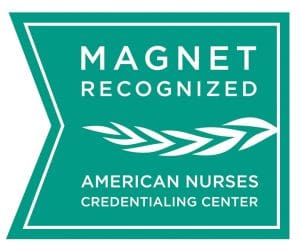Emergent change requires a framework that supports nurses.
Takeaways:
- Settings enculturating the Magnet® framework were better able to cope with pandemic-related challenges.
- The pandemic healthcare environment requires bold nursing leadership to reset today’s normal for nursing and discover innovative solutions.
Challenges presented by the COVID-19 pandemic have compelled all nursing leaders to rapidly modify existing patient care structures and processes. In early 2020, the first U.S. COVID-19 patient volume models predicted implications for clinical care and preparation for surge modeling. Clinicians providing care at the beginning of the pandemic immediately recognized the ravaging pulmonary effects of the virus and anticipated an unprecedented need for interventions such as prone positioning, high-flow oxygen, mechanical ventilators, and thrombosis prevention and treatment. Leaders and bedside nurses also had to learn how to manage social distancing, personal protective equipment (PPE) accessibility and reuse, and restrictions on nonessential staff entering rooms of patients with COVID-19.
During the early stages of the pandemic, hiring slowdowns at most major healthcare organizations, in response to diminished elective and other discretionary patient care, reduced workforce resources. As the situation intensified and lack of workplace human connection continued (as a result of social distancing, increased patient mortality, and complicated patient care), staff began to demonstrate symptoms of emotional and physical fatigue. In many organizations, visitor limitations required nurses to serve as surrogates in the absence of family presence, most poignantly during difficult conversations about care and at patient deaths.
The already rapidly changing healthcare landscape, calls for social justice, and new and existing political issues further complicated the pandemic. Challenges exceeded pandemic-related patient care and quickly exacerbated the nursing shortage already predicted due to early retirements, shifting nursing practice role paradigms, staff quarantines as a result of COVID-19 exposure, and increased traveling and temporary nurse assignments.
Our mid-Atlantic health system, Sentara Healthcare, consists of 12 hospitals, nine of which have achieved Magnet® designation, beginning with the first in 2006. All of our hospitals are on active Magnet journeys. Nurse leaders hypothesized that our settings, which enculturate the Magnet framework, were well-positioned to cope with pandemic-related challenges. The phases of the pandemic focused on creating an initial and then ongoing capacity to respond to potential and actual patient demands as we better understood the virus and clinical care approaches. Our work to develop and sustain a successful response to the pandemic aligns with the Magnet model components (Transformational Leadership, Structural Empowerment, Exemplary Professional Practice, New Knowledge, and Empirical Quality Outcomes), which support the program’s framework for high-quality care and job satisfaction. (See About the Magnet framework.)
About the Magnet® framework


ANCC Magnet nursing cultures embrace change and encourage nurses to use data and best practices to create structures, processes, and responses that improve outcomes and optimize performance. Organizations on an initial or continued Magnet designation journey align with five components of the Magnet Model:
- Transformational Leadership calls for leaders to communicate with and advocate for their teams.
- Structural Empowerment requires organizations to develop partnerships at all levels, identify shared governance processes, and establish professional development improvement goals.
- Exemplary Professional Practice builds a culture based on a professional practice model that focuses on safety and multiple data points to demonstrate satisfaction and clinical indicator performance.
- New Knowledge, Innovation, and Improvements expect organizations to integrate evidence-based practice and nursing research into care.
- Empirical Quality Outcomes (categorized as clinical nursing, patient and consumer, and organizational) follow from strong structures and processes.
All components woven into a Magnet culture support aspiring, designating, and re-designating organizations to focus on superior quality outcomes benchmarked to national standards. To learn more about the Magnet journey, visit nursingworld.org/organizational-programs/magnet.
Transformational Leadership
Our transformational leadership culture led to extraordinary efforts to obtain essential PPE amid global scarcity. We implemented innovative conservation strategies of safe PPE reuse and bundled care to limit staff exposure and conserve precious resources.
As the pandemic continued and new care standards emerged, nurse leaders supported clinical nurses through numerous practice changes. A significant aspect of leadership included prompt approval of decisions (for example, placing I.V. pumps outside of patient rooms, reusing PPE safely, allocating space and resources for increasing patient volume, and designating COVID units). Care bundling strategies and shifting care delivery models established the nurse as the priority clinician in the patient room.
Our organization activated a reduced electronic health record (EHR) documentation navigator to provide quick-access buttons for frequently used flowsheet rows. Condensed admission, discharge, and shift navigators focused only on essential information required during the sustained crisis. The streamlined EHR process reduced the amount of time nurses spent documenting so they could spend more time with patients. Leaders took on complex and laborious approval processes, resulting in a new structure that we’ve adapted for continued use.
Structural Empowerment
Fragkos and colleagues found strong correlation between structural empowerment and the organizational commitment of nurses. Magnet fundamentals inspire nurses at all levels to have a voice in advocacy and patient care outcomes.
Our health system defines shared governance as a working model of participation in which nurses make decisions about clinical practice standards, quality improvement efforts, staff and professional development, and nursing research. Nurses are well versed in system-, hospital-, and unit-level shared governance structures and the role of evidence-based practice guidelines in ongoing care delivery.
During the pandemic, virtual shared governance (consisting of clinical nurse and nurse leader representatives from each hospital) guided specialty nursing practice, policy, procedures, competencies, and educational training programs. When care bundling and PPE limitations required innovation, clinical nurses advocated using extended tubing on I.V. pumps outside patient rooms to support modified care standards. The clinical nurses developed a system-wide policy and procedure to guide safe, standardized practice.
Our organization rapidly pivoted in-person professional development programs to synchronous and asynchronous virtual offerings to support initial competencies and ongoing professional development role progression. Socially and culturally sensitive care, a hallmark of Magnet organizations, led to one of the first-in-the-nation transparent face masks. The mask was created by one of our organization’s labor and delivery nurses in the first days of the pandemic to support a lip-reading father during his family’s birth experience.
Exemplary Professional Practice
Our 2021 nursing satisfaction survey performance on leadership access and responsiveness and interprofessional relationships improved during the pandemic. Perceived contributory factors include increased leader rounding, expanded huddles, and frequent leadership communication.
Our professional practice model maintained a clear focus on how nurses practice, function, interact, and collaborate to provide high-quality care. As the primary caregivers in patient rooms, clinical nurses assumed additional responsibilities within their scope. Their adaptability and flexibility allowed them to take on new challenges to meet patient needs.
New Knowledge, Innovation, and Improvements
Magnet organizations foster innovation as a cultural norm. Sentara Healthcare’s clinical workforce redeployment included just-in-time training and shifting care delivery from a primary model to a team and functional model. Nonpatient care extender roles supported overburdened units, and interdepartmental collaboration ensured that redeployed staff received immediate access to and training on the inpatient EHR. When clinical nurses advocated for technology to enable family members to communicate with loved ones during limited bedside visitation, the organization quickly reassigned devices for use with social media platforms, which connected patients and families across the continuum of care. Clinical nurses also partnered with providers to facilitate inpatient telehealth visits to support continuation of timely bedside consults.
Magnet culture requires a spirit of scholarly inquiry. As in-person meeting attendance dropped in response to social distancing requirements, dissemination opportunities shifted toward manuscripts and virtual conferences. In addition, our organization’s nurses led ground-breaking research on moral distress and resiliency related to the unrelenting demands of the sustained situation. Sheppard and colleagues identified that moral distress related to the work environment significantly impacts nurse retention and that supporting nurses to cope with moral distress can improve that environment.
Empirical Outcomes
Throughout the pandemic, our organization’s nurses remained focused on data and outcomes. This intense focus prompted early recognition of an increased need for preventing respiratory device–associated pressure injuries secondary to prone positioning, which led to interdisciplinary collaboration and improvement efforts.
Although episodic nurse-sensitive indicator rates increased at the height of each pandemic surge, the overall central line–associated blood stream infection, catheter-associated urinary tract infection, and hospital-acquired pressure injury incidence rates decreased in 2021 compared to 2020. Falls with injury is the one nurse-sensitive clinical indicator we’re seeing increases in compared to pre-pandemic rates.
Future implications
Concerns about completing quality Magnet documents and navigating new virtual site visits during the pandemic have proven unfounded in our experience. Three Sentara Healthcare hospitals conducted site visits between March 2020 and May 2021, and two sites hosted completely virtual visits. In the spirit of Magnet inquiry, we conducted a post-site visit survey of our clinical nurse escorts to evaluate the impact on them and our Magnet nursing culture. The survey concluded that both in-person and virtual site visit experiences led to improved resiliency, coping, and stress reduction, resulting in a 100% retention of those individuals serving in the Magnet escort role. The reported experience provided a global perspective of the organization for these nurses, which led to a stronger sense of ownership of the Magnet designation outcome. For our organizations, virtual visits continue to support the Magnet process and nurse engagement.
Sustaining a Magnet journey hasn’t been easy as the months have turned into years of the pandemic. We’ve witnessed patient satisfaction challenges resulting from reduced visitation policies as well as changing patient and family dynamics and behaviors. New nurse preparation practice gaps require additional emphasis on transition-to-practice programs—key to the Magnet journey—when some in professional development roles face deployment for direct patient care. Outmigration of experienced senior nurses has created challenges to traditional nurse expert mentorship, another hallmark of Magnet, and reduced energy and focus prevent some nurses from pursuing specialty certifications and degree advancement. Our organization has established and met improvement goals, but at a lower rate. Continuing attention to these outcomes is critical.
Ongoing implications for all nurses must include adopting nursing excellence principles, Magnet component structures, and the discipline to support a professional practice environment regardless of formal designation. However, Magnet remains the gold standard for nursing excellence. The post-pandemic healthcare environment will require bold thinking and leadership by all nurses to reset today’s normal for nursing and discover new, innovative solutions. The recently updated Nursing: Scope and Standards of Practice and the timely release of Future of Nursing 2020–2030: Charting a Path to Achieve Health Equity call on all nurses to lead. Historic programs, models, frameworks, and offerings may no longer be relevant or even appropriate. Nurses must embrace a culture of “why not” and “what if.” At Sentara Healthcare we say that Magnet nurses always find a way to get to yes. The hallmarks of Magnet culture helped our teams face the challenges of the past several years and will point us in the right direction for our future together.
The authors work at Sentara Healthcare. Susan A. Winslow is system director of professional practice and clinical education in Chesapeake, Virginia. Genemarie W. McGee is corporate vice president/system chief nursing officer in Norfolk, Virginia. Catherine V. Smith is system director of advanced nursing practice/patient outcomes in Norfolk.
References:
American Nurses Credentialing Center. 2019 Magnet® Application Manual. Silver Spring, MD: American Nurses Credentialing Center; 2017.
Fragkos KC, Makrykosta P, Frangos CC. Structural empowerment is a strong predictor of organizational commitment in nurses: A systematic review and meta-analysis. J Adv Nurs. 2020;76(4):939-62. doi:10.1111/jan.14289
Sheppard KN, Runk BG, Maduro RS, et al. Nursing moral distress and intent to leave employment during the COVID-19 pandemic. J Nurs Care Qual. 2022;37(1):28-34. doi: 10.1097/NCQ.0000000000000596


















